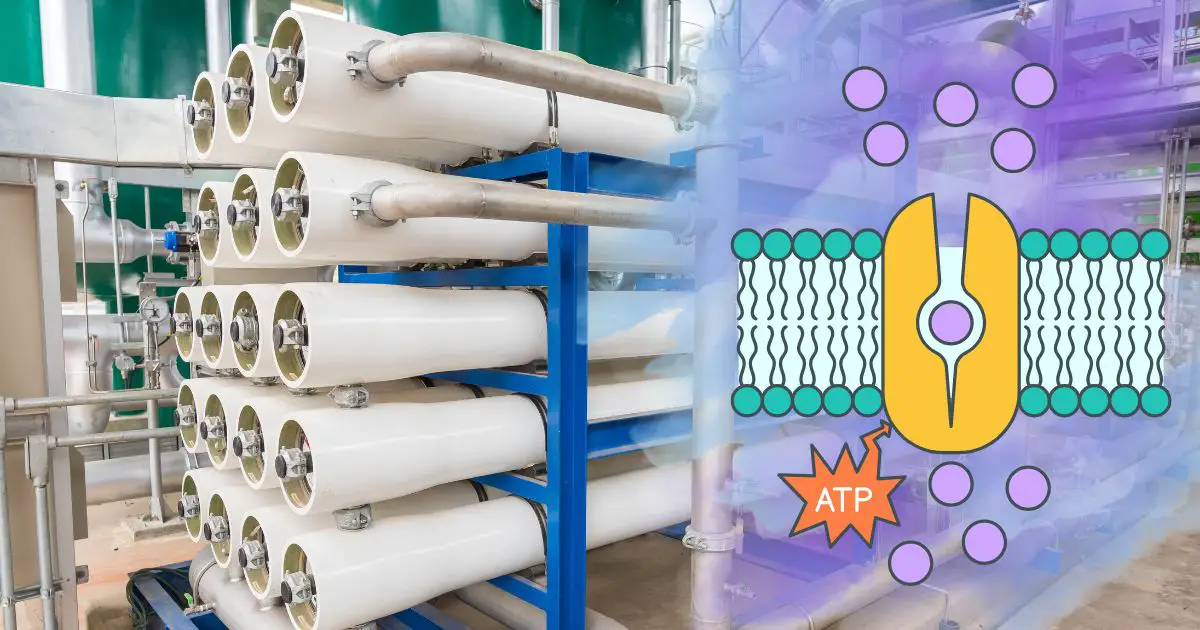Water purification is essential for clean and safe drinking water, and reverse osmosis (RO) is one of the most effective filtration methods used worldwide. But is reverse osmosis active transport?
This article will explore the science behind reverse osmosis, how it compares to active and passive transport, and its role in biological and industrial applications.
What is Reverse Osmosis?
Definition and Process
Reverse osmosis (RO) is a water filtration process that removes contaminants, dissolved solids, and impurities by forcing water through a semi-permeable membrane. This membrane allows only water molecules to pass while blocking:
✅ Salts and minerals
✅ Heavy metals (lead, mercury, arsenic)
✅ Bacteria and viruses
✅ Chlorine and fluoride
✅ Pesticides and nitrates
How Reverse Osmosis Works
- Pre-Filtration – Removes large particles like dirt, sediment, and chlorine.
- High-Pressure Pumping – Water is forced against the membrane using external pressure.
- Membrane Filtration – The semi-permeable membrane blocks impurities and dissolved solids.
- Storage and Post-Filtration – Clean water is stored and may go through a final carbon filter to improve taste.
This process is used in household drinking water systems, industrial water purification, and desalination plants.
What is Active Transport?
Definition of Active Transport
Active transport is a biological process where cells use energy (ATP – Adenosine Triphosphate) to move molecules against their concentration gradient (from low to high concentration). This is the opposite of passive diffusion, which moves molecules from high to low concentration without energy use.
Types of Active Transport
There are two main types of active transport:
- Primary Active Transport – Directly uses ATP to move substances. Example: Sodium-Potassium (Na+/K+) Pump.
- Secondary Active Transport – Uses energy from an ion gradient created by primary active transport. Example: Glucose-Sodium Cotransport.
Why Do Cells Use Active Transport?
- Maintaining ion balance (e.g., sodium, potassium, calcium).
- Nutrient absorption in digestion.
- Nerve signal transmission for muscle movement.
Is Reverse Osmosis Active Transport?
The short answer is no, reverse osmosis is not active transport because:
- It does not use ATP (biological energy).
- It relies on external pressure, not cellular processes.
- It moves water from high to low concentration, opposite of active transport.
Instead, reverse osmosis is a physical filtration process, which is different from the biological mechanisms of active transport.
Key Differences Between Reverse Osmosis and Active Transport
| Feature | Reverse Osmosis | Active Transport |
|---|---|---|
| Energy Required? | Yes, but from external pressure | Yes, uses ATP |
| Movement Direction | High to low concentration | Low to high concentration |
| Membrane Type | Semi-permeable (physical filtration) | Selective (biological transport) |
| Example | Water purification | Sodium-Potassium Pump |
| Occurs in? | Industrial & household filters | Living cells |
Is Reverse Osmosis Passive Transport?
Although reverse osmosis is not active transport, it is also not purely passive transport either.
What is Passive Transport?
Passive transport moves molecules without energy from high to low concentration and includes:
- Simple Diffusion – Molecules move freely across a membrane.
- Example: Oxygen entering cells.
- Facilitated Diffusion – Uses protein channels but no energy.
- Example: Glucose transport in red blood cells.
- Osmosis – Movement of water through a membrane.
- Example: Water absorption in plant roots.
Since reverse osmosis requires external pressure, it is a forced process, not passive transport.
Where Does Reverse Osmosis Fit?
Reverse osmosis is a physical filtration process, rather than a biological transport mechanism. It is a pressure-driven separation process that does not depend on passive or active transport principles.
Real-World Applications of Reverse Osmosis
1. Drinking Water Purification
- Removes contaminants like lead, arsenic, and chlorine.
- Used in household water filters and bottled water production.
2. Desalination (Turning Seawater into Freshwater)
- Used in coastal cities and water-scarce regions to remove salt from seawater.
- Saves millions of people from water shortages.
3. Industrial Applications
- Used in pharmaceutical, food, and beverage industries to ensure pure water.
- Essential for semiconductor manufacturing, where ultra-pure water is needed.
4. Medical and Laboratory Use
- Provides sterile water for hospitals and research labs.
- Used in kidney dialysis machines to purify blood.
Conclusion: Reverse Osmosis vs. Active Transport
✅ Reverse osmosis is NOT active transport because:
It does not use ATP or biological energy.
It relies on external pressure, not cellular mechanisms.
It moves water from high to low concentration, opposite of active transport.
Instead, reverse osmosis is a pressure-driven filtration process used in water purification, desalination, and medical applications.
If you’re looking for a highly effective way to purify water, reverse osmosis is one of the best solutions available today.
Would you like to know the best reverse osmosis filters for your home? Let me know! 🚰💧
